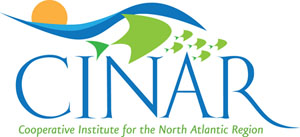Researchers seek to learn what lies beneath the Gulf of Maine
 |
| The young Henry Bigelow. |
The Grampus was an awkward wooden sailing vessel, but for Henry Bryant Bigelow in 1912, this boat was the golden key to unlocking the Gulf of Maine.
Named for a large dolphin, Grampus was built along the lines of a typical New England fishing schooner to collect live fish for the U.S. Bureau of Fisheries. It was aboard Grampus that 33-year-old Bigelow began a 12-year exploration of the Gulf of Maine, a life-changing scientific voyage of discovery that he referred to a friend blithely as an attempt to find out “where the cold water comes from.”
Curiosity has never been in short supply in the Gulf of Maine. From the explorations of Giovanni da Verrazzano and the early Basque sailors in the 1500s to the voyages of Samuel de Champlain and George Waymouth, Europeans have been prowling the Gulf for more than five centuries. For most, interest was principally mercantile. The white pine forests along the shore, abundant cod and clams in the coastal waters, whales, seabirds and other life translated into money and prestige for most early explorers.
Scientific investigation of the Gulf of Maine lagged many centuries behind its physical exploration. Rudimentary bathymetric surveys of the Gulf began in 1854 under the direction of the U.S. Coast Survey and continued for more than two decades. It wasn’t until 1870 that Addison E. Verrill, the renowned Yale University zoologist born in Greenwood, Maine, attempted to take subsurface temperature readings.
Yet not until Bigelow did a true scientific understanding of the Gulf of Maine emerge. Bigelow wrote in his monograph on Gulf of Maine plankton (published in 1926), “…Few living zoologists have been as fortunately placed as were we on setting sail on the Grampus from Gloucester on our first oceanographic cruise in the Gulf of Maine on July 9, 1912, for a veritable mare incognitum lay before us, so far as its floating life was concerned…” He added, “…everything was yet to be learned as to what groups or species would prove predominant in the pelagic fauna…We even had no idea (incredible though it may seem in this place and day) what we should probably catch when we first lowered our tow nets into deeper strata….for, so far as we could learn, tows had never previously been tried more than a few fathoms below its surface.”
Bigelow, of Boston
Henry Bryant Bigelow was born in Boston in 1879, into a wealthy Beacon Hill family. As an undergraduate at Harvard University, Bigelow joined his first natural history expedition in 1900, sailing to Newfoundland and Labrador. In 1901 he persuaded Alexander Agassiz, son of Louis Agassiz, founder of the university’s Museum of Comparative Zoology, to take him on an expedition to the 26 atolls that comprise the Maldive Islands off India. Young and well-to-do, Bigelow extended his journey to include a trip around the world. When he returned, he turned his studies of medusae, transparent polyp-like creatures that syphon large volumes of sea water, into his Ph.D. dissertation, which he was awarded from Harvard in 1906.
 |
| An older Henry Bigelow. |
With a doctorate in hand, Bigelow was promptly hired by the Museum of Comparative Zoology. Eventually he became curator of oceanography for the museum. At the suggestion of Sir John Murray, Bigelow organized the first comprehensive study of the Gulf of Maine under the aegis of the museum and the U.S. Bureau of Fisheries, which loaned him Grampus. Bigelow used a crew to sail Grampus and often conducted his research alone and seasick.
From 1912 to 1928, he and the crew sampled 350 stations across the Gulf for measurements of temperature and salinity, set 10,116 tows, and let loose 1,000 drift bottles, which provided Bigelow the data to identify the non-tidal current systems of the Gulf and Georges Bank.
Fishes of the Gulf of Maine is one of the publications for which Bigelow and his colleague William Schroeder are most often remembered. Originally published in 1925, it was a taxonomist’s delight, the first comprehensive authority on life in the Gulf of Maine. The book listed 83 families of fish comprising 178 distinct species and provided data on plankton and currents found in the Gulf. Bigelow and Schroeder updated the tome in 1953, at which time they added 25 additional families of fish and described 41 additional individual species. Fishes of the Gulf of Maine was revised yet again in 2002 by the Smithsonian Institution. By this time scientists had discovered 118 families of fish in the Gulf for a total of 252 species.
After completing his work on the Gulf of Maine, Bigelow went on to many other adventures. He was the first director of the Woods Hole Oceanographic Institute in Massachusetts from 1930 to 1939. He continued to serve as curator of oceanography for the museum, retiring from that position in 1962. He wrote an aptly titled memoir in 1964 called Memories of a Long and Active Life in which he recounted numerous big-game hunting and fishing exploits around the globe. He died at his home in Concord, Massachusetts, in 1967.
Today’s research
While Bigelow and other early 20th century scientists relied solely on the traditional technique of first-hand observation to gain knowledge about the Gulf of Maine, today’s explorers use a multitude of high-tech tools in their explorations. Remotely operated vehicles skim through the water column, cod and salmon marked with tiny acoustic tags swim their migration routes, and self-reporting buoys consistently return data on the physical aspects of the Gulf.
 |
| GoMOOS map showing GoMOOS buoy N. |
The Gulf of Maine Ocean Observing System (GoMOOS) began in 2000 as a national pilot program designed to bring hourly oceanographic data from the Gulf of Maine to all those who need it. The non-profit organization is supported by the U.S. federal government, universities and private firms that draw upon its feed of data.
In 2001, GoMOOS deployed 10 buoys from Massachusetts Bay to the Bay of Fundy to obtain myriad types of data both above and below the sea surface. Measurements at the surface include wind, waves, temperature and fog. Below the surface, GoMOOS buoys take measurements of currents, temperature, salinity, color, turbidity and dissolved oxygen. The data is available through the organization’s website, RSS (Really Simple Syndication) feeds and through a Distributed Oceanographic Data system.
GoMOOS data have aided scientists at the University of Maine who track the North Atlantic Oscillation (NAO). The NAO is similar to the better-known El Nino phenomenon in the Pacific Ocean. The oscillation is based on the pressure difference between air over Iceland and air over the Azores in the middle Atlantic. When pressure is high over the Azores and low over Iceland, the northeastern United States tends to have mild, wet winters. When the pressure gradient reverses, then cold air and high snowfalls occur. The NAO is the dominant influence on the weather in the Gulf of Maine. However, until recently, scientists found it difficult to obtain the volume of data necessary to predict if or when the NAO shifts would occur.
Changes in the winds as a result of the NAO cause alteration in the strength and direction of ocean currents in the North Atlantic, including deep currents that flow into the Gulf of Maine through the Northeast Channel. In particular, the NAO influences water flowing at 150-meter (492 feet) depths into the Gulf of Maine from the continental slope through the Northeast Channel. Either of two distinct, deep water masses—one cold, one relatively warm—may predominate along the continental slope outside the Channel.
Approximately one year after the NAO index becomes positive (high pressure over the Azores), warm slope water will enter the Northeast Channel and the Gulf. Conversely, one year after the NAO index becomes negative (low pressure over the Azores), cold Labrador slope water enters through the Northeast Channel. The two water masses differ in temperature and the nutrients that they carry, thus the Gulf of Maine ecosystem will change as the water masses vary.
GoMOOS buoy N01 situated in 738 feet (224 meters) of water in the Northeast Channel provides scientists such as Neal Pettigrew, associate professor of physical oceanography at the University of Maine, with the regular data necessary to determine which water mass is entering the Gulf. “GoMOOS helps us make significant progress on some of the problems we’ve been studying around the Gulf of Maine for 50 years,” Pettigrew said.
Since the buoys have been deployed, Pettigrew and his colleagues have improved their data-gathering abilities. They have devised and installed a new inductive modem system, which is a method for sending the data from submerged sensors up to the surface buoy. The inductive modem technique uses the voltage fluctuation generated by the sensor to move the data into the steel cable that tethers the buoy in place. The electrical data signals then move up the cable to the buoy where they are relayed to land.
 |
| Buoy being serviced. Photo credit: NOAA |
Not only are these buoys generating more data each hour than Henry Bigelow could have imagined, but now autonomous undersea gliders are plying the Gulf of Maine 24 hours a day as well. The first glider entered the Gulf in 2006 and delighted its University of Maine creators with a two-week self-directed cruise. Mary Jane Perry, a professor of marine sciences and oceanography at the university’s Darling Marine Center, reported that the glider cruised through the water column at just under one mile per hour, around the clock, seven days per week.
The glider is designed to swoop through the water rising and falling slowly. Using an internal piston that alternately draws in and expels sea water from a chamber in the rear section of its housing, the glider changes its buoyancy by changing the ratio of internal seawater to oil, which is stored in a bladder in the nose of the device. The buoyancy changes translate into forward motion. They use low-power sensors to gather data on dissolved oxygen, phytoplankton biomass and suspended particle concentrations, among other chemical and biological variables.
At intervals the glider will rise to the surface to transmit its accumulated data back to land. It maintains a predetermined course by checking its position via GPS or it will accept new instructions from researchers working from a ship or mainland lab.
“One of the main advantages of gliders is their persistent presence in the ocean,” said Perry. “They give us the ability to gather data and observe features over time that might never be observed using satellites or other platforms. If you have to wait for a ship, you might entirely miss an important event.”
Ocean Tracking Network
In Halifax, Nova Scotia, oceanographers are gathering data not only in the Gulf of Maine but in all five of the world’s oceans via an ambitious ocean observation program called the Ocean Tracking Network. Housed at Dalhousie University, the Ocean Tracking Network aims to track ocean currents, water masses and marine species and correlate those data with climate changes.
The world’s oceans are closely linked to the world’s climate. They determine dominant weather patterns; any significant changes can trigger natural disasters such as unprecedented flooding or conversely, debilitating drought. The Ocean Tracking Network draws upon hundreds of researchers to gather data in an effort to obtain timely analyses of how marine life and the climate are changing worldwide. The ultimate goal is to establish up to 60 acoustic curtains around the world sending data in real time from 14 continental shelf regions off all seven continents.
The Ocean Tracking Network is based on small, inexpensive transmitter tags that are surgically implanted in animals. Battery-powered acoustic receivers about the size of a large soda bottle are attached to heavy steel wheels or concrete blocks to anchor them to the sea floor. Placed at regular intervals, 50 to 200 receivers can form an acoustic curtain up to 31 miles long. As a tagged animal approaches the curtain, the nearest receiver logs the tag’s serial number, the date and time. Movement patterns of individual animals, including direction and speed, can be reconstructed using the time of detection at different receivers and other acoustic curtains.
Researchers involved in the program recently discovered where the elusive Gulf of Maine salmon go when they leave their home rivers each year.
Atlantic salmon tagged with tiny acoustic transmitters crossed an acoustic curtain deployed as part of the Ocean Tracking Network in the waters off Halifax in June, 2008. The fish had been tagged earlier that spring in the Penobscot River by the National Oceanic and Atmospheric Administration (NOAA) and the U.S. Geological Survey (USGS). As the fish passed by the submerged receivers, the receivers recorded their signals and data about their passage was then downloaded to a Canadian Department of Fisheries and Oceans (DFO) research vessel via modem.
One hundred salmon were tagged in Maine with the transmitters. Each fish transmitter has an individual code and gives specific information about its activity such as speed and migratory habits. Approximately 30 percent of the tagged fish’s signals were picked up by the Halifax receivers.
“In Maine, traditional methods of restoring Atlantic salmon by stocking fish have not been very successful, with only 0.68 percent returning,” said Michael Stokesbury, director of research for the Ocean Tracking Network. “With the tagged salmon we can track more fish further into the ocean than ever before and get meaningful results.”
Meaningful results are what led Henry Bigelow to the Grampus nearly a century ago. The desire to know what lies beneath the surface of the Gulf of Maine—“where the cold water comes from”—still motivates men and women to dedicate their lives to exploration. Today the tools of modern science are more likely to be an unseen underwater glider than a hemp tow net and a microscope. But the delight of discovery remains the same.
Online Resources:
Fishes of the Gulf of Maine – the complete text of Bigelow’s groundbreaking work, as published online
More biographical information on Henry Bigelow from the Bigelow Laboratory for Ocean Sciences
Gulf of Maine Ocean Observing System (GoMOOS)
NOAA’s National Weather Service North Atlantic Oscillation (NAO) page
Gulf of Maine Research Institute (GMRI) and Gulf of Maine Ocean Observing System (GoMOOS) merge – Nov 9, 2009
“Ocean Tracking Network to shed light on undersea life,” Gulf of Maine Times 2007
Print


















